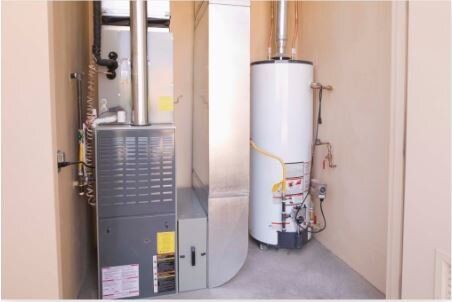In the previous article we discussed the different types of furnaces. This article expands on that, going deeper into the size furnace that is best for your home.
The size of a furnace is based on how much heat it can produce in an hour, which is measured in BTUs (British thermal unit).
The BTU usage recommended for each home is not a single number but rather a broad range as you can see below:
- 1,200-square-foot house: 36,000 to 72,000 BTUs
- 1,500-square-foot house: 45,000 to 90,000 BTUs
- 1,800-square-foot house: 54,000 to 108,000 BTUs
- 2,100-square-foot house: 63,000 to 126,000 BTUs
- 2,400-square-foot house: 72,000 to 144,000 BTUs
Buying the right size heater is vital because over or underestimating the size will cause you to feel uncomfortable in your home, and it’ll be less efficient.
For example, selecting the incorrect size furnace will also shorten the lifespan of your system. Too large of a furnace will require frequent turning on and off, making it less energy-efficient and causing the system to fail prematurely. It’ll warm up too quickly and cause your home to be uncomfortably hot. Too small of a furnace will cause high energy bills since its constantly running, a shorter lifespan, and uneven heating (cold and hot spots in the house). The furnace won’t be able to keep up with the coldest days of winter.
To find the right size, you’ll first need to calculate the square footage of your home. You’ll have to measure the areas of your rooms (whether they would be rectangular, circular, triangular or any other unusual shape).
Next, you’ll need to find the climate zone that your home is in. Generally speaking, the farther from the equator you’re located, the more BTUs it will take to heat a square foot of your home. However, some geographic factors such as elevation and ocean currents cause BTU requirements to vary at any given latitude. To find out which climate zone you are located in, click here
That should be it, right?….. Wrong
Some other factors you’ll need to consider:
Windows, exposure to the sun, the number of dwellers, the kitchen, the number of floors, age of your home, the desired temperature, the ceiling height, the ceiling fans, the ductwork, the color of your roof and finally the shape of your house.
Simple, right?
Even though all the factors that affect your BTU requirements have been explained, it can still be a daunting task to calculate them yourself. If you’d like to be sure you have the correct size furnace in your home, call us today to schedule an appointment!

